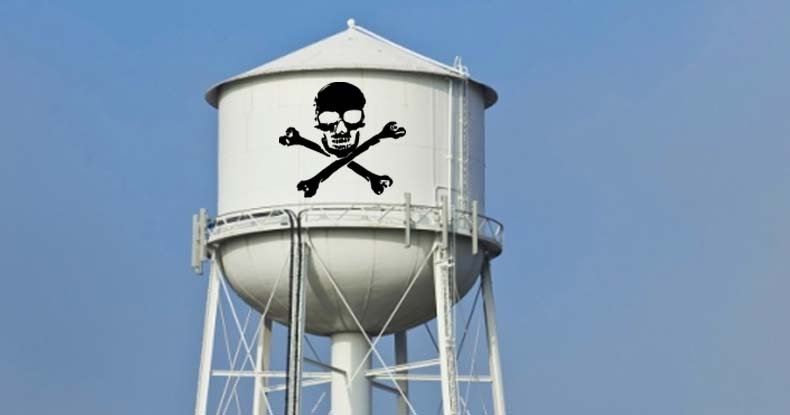
According to a new report, some 18 million Americans “live in communities where the water systems are in violation of the law.”
Flint apparently marked the tip of a nefarious iceberg, and lead isn’t the only contaminant polluting drinking water for millions in the United States.
“Imagine a cop sitting, watching people run stop signs, and speed at 90 miles per hour in small communities and still doing absolutely nothing about it — knowing the people who are violating the law. And doing nothing,” illustrated Erik Olsen, health program director at the Natural Resources Defense Council, which analyzed EPA data for the report. “That’s unfortunately what we have now.”
According to the NRDC’s scathing report, “What’s In Your Water? Flint and Beyond,” lead contamination in Flint — the subject of national outrage and scandal — is “not anomalous.”
In fact, 5,363 water systems in the U.S. in 2015 violated the federal Lead and Copper Rule — putting around 18 million people at risk of consuming those contaminants — and virtually none of those responsible faced any penalties, much less criminal charges.
“For more than a year, government officials callously downplayed or ignored Flint’s toxic water and the majority-black community’s cries for help,” the report asserts. “Federal EPA, state, and state-appointed local environmental officials belittled and refused to listen to Flint residents and their advocates.”
Startlingly, Flint was not listed among the communities with lead-tainted water despite ongoing contention, scandal, and controversy, a responsibility of the Michigan Department of Environmental Quality — itself directly involved in the scandal.
In addition to an acerbic critique of the Flint water crisis — blamed partially on inadequate guidelines and regulatory rules — the NRDC study found over 1,000 community water utilities exceeded ‘actionable’ lead levels set forth by the EPA. According to the report:
These violations included failures to properly test the water for lead or conditions that could result in lead contamination, failures to report contamination to state officials or the public, and failures to treat the water appropriately to reduce corrosion.
Some 3.9 million people were subjected to the water with levels above 15 parts per billion (ppb) — at least 10 percent of homes tested — in 1,110 community supplies.
Rather alarmingly, the true extent of the contamination of water supplies in the U.S. might not be fully understood. According to the NRDC, underreporting — an issue known to the EPA — is endemic for several reasons.
Natural and Non-Toxic Products. Up to 50% Off – Every Day (Ad)
Improper monitoring, “using testing methods or strategies that avoid detecting contamination,” prevents violations from being accurately recorded or reported, while incorrect documentation and simple failures in reporting violations to the EPA for its database are all common.
As in the case of Flint, these failings around the country “may hide serious health threats.” The report continues:
NRDC has documented underreporting problems in the EPA’s drinking water database for 25 years; the EPA itself admits that ‘audits and assessments have shown that violation data are substantially incomplete.
Despite the astronomical number of violations — and public at risk because of them — lack of enforcement and penalty run rampant.
[A]ccording to the EPA’s data, states and the EPA took formal enforcement action against just 11.2 percent of the over 8,000 violations that occurred in 2015 — leaving 88.8 percent free from any formal enforcement action. Formal enforcement actions were taken against less than one in five health-based violations (17.6 percent). Furthermore, penalties were sought or assessed for only a tiny fraction (3 percent) of violations.
To resolve or alleviate the issue of widespread contamination, NRDC recommends “significant investment” in water infrastructure nationwide, including the replacement of over 6 million lead service lines, replacing aging or decaying portions of distribution systems, and improvements at treatment plants.
Further recommendations include necessary clarification and updating of regulations and rules surrounding acceptable levels of various contaminants, including the go-to but oft-violated EPA Lead and Copper Rule.
While Flint marked a departure from the norm, or an outright shift in roles, with dedicated citizens and scientists committed to exposing lead contamination, the report notes, but,
We cannot expect such an unlikely set of watchdogs to emerge in the face of every lead crisis.
Indeed, NRDC cautioned, “As long as we have this culture of hiding violations and attacking staff members who do their jobs, more Flints can be expected.”
Claire Bernish writes for TheFreeThoughtProject.com, where this article first appeared.
Disclaimer: We at Prepare for Change (PFC) bring you information that is not offered by the mainstream news, and therefore may seem controversial. The opinions, views, statements, and/or information we present are not necessarily promoted, endorsed, espoused, or agreed to by Prepare for Change, its leadership Council, members, those who work with PFC, or those who read its content. However, they are hopefully provocative. Please use discernment! Use logical thinking, your own intuition and your own connection with Source, Spirit and Natural Laws to help you determine what is true and what is not. By sharing information and seeding dialogue, it is our goal to raise consciousness and awareness of higher truths to free us from enslavement of the matrix in this material realm.
 EN
EN FR
FR

























